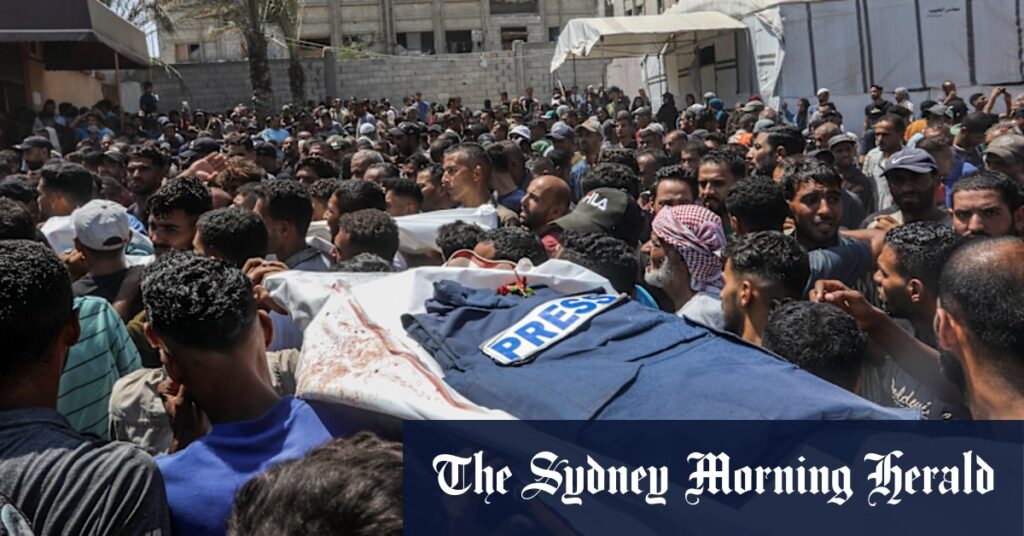
An initial strike hit the top floor of a hospital building in Gaza, abruptly cutting off a live video feed operated by Reuters cameraman Hussam al-Masri. Tragically, Masri was killed in the attack. The news agency had been broadcasting daily feeds from Nasser Hospital throughout the Gaza conflict, using its own camera equipment. Hospital officials reported that a second person, yet to be identified, also died in the first strike.
As health workers, journalists, and relatives of patients rushed up an external staircase to reach the site of the first blast, a second strike hit. Photos captured from below showed at least 16 people on the staircase, including emergency responders and health workers, none of whom were armed. Video footage from Al-Ghad TV documented the second strike, which engulfed the staircase in smoke and resulted in 18 fatalities.
Journalists Targeted in the Conflict
The attack claimed the lives of several journalists, including freelance photographer Mariam Abu Dagga, Mohammed Salama from Al-Jazeera, Moaz Abu Taha, a freelancer occasionally working with Reuters, and Ahmed Abu Aziz from Middle East Eye. Reuters contractor Hatem Khaled was wounded. The military has not clarified the reason for the second strike or how militants were identified among the crowd.
Israeli Prime Minister Benjamin Netanyahu described the attack as a “tragic mishap.” However, Israel has previously identified emergency responders under the Hamas-run government as militants, a claim often lacking evidence. This incident has sparked international condemnation, with rights groups decrying the “double tap” tactic, which has been criticized in other conflicts like those in Ukraine and Syria.
Global Outcry and Calls for Accountability
The United Nations Human Rights Office spokesperson Thameen al-Kheetan stated,
“The killing of journalists in Gaza should shock the world. Not into stunned silence but into action, demanding accountability and justice.”
The Committee to Protect Journalists reports that 189 Palestinian journalists have been killed by Israeli fire in Gaza over 22 months of fighting, making it one of the deadliest conflicts for media workers.
According to a military official, both strikes on the hospital were launched from a tank. International law prohibits attacks on hospitals unless they are used for military purposes, and even then, strikes must be proportionate and spare civilians. Israel has repeatedly attacked hospitals throughout the conflict, claiming Hamas embeds itself in these facilities, though evidence is seldom provided.
Political and Humanitarian Repercussions
Protests erupted in Israel as Netanyahu considered an offensive into Gaza City, which he argues is necessary to defeat Hamas. Meanwhile, Palestinians in Gaza face displacement, destruction, and famine. Netanyahu has vowed to continue the offensive while pursuing a ceasefire, though no negotiating team has been sent to discuss proposals.
Hamas took 251 hostages on October 7, 2023, in an attack that killed approximately 1,200 people. While most hostages have been released during previous ceasefires, Israel has only managed to rescue eight alive, with 50 still in Gaza. Israeli officials believe around 20 remain alive.
Continuing Conflict and Casualties
A day after the hospital attack, Israeli strikes killed at least 35 Palestinians across the Gaza Strip, according to reports from Nasser Hospital, Shifa Hospital, and Gaza City’s Sheikh Radwan Clinic. The Gaza Health Ministry reported three additional deaths related to malnutrition, raising the malnutrition-related death toll to 186 since late June, including 117 children.
According to Gaza’s Hamas-run Health Ministry, Israel’s military offensive has resulted in 62,819 deaths, with around half being women and children. The figures do not differentiate between fighters and civilians.
The ongoing conflict continues to draw international scrutiny and humanitarian concerns as both sides grapple with the devastating impacts on their populations.







